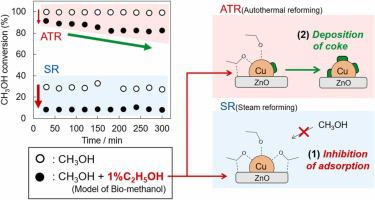Applied Catalysis B: Environment and Energy ( IF 20.2 ) Pub Date : 2023-01-06 , DOI: 10.1016/j.apcatb.2023.122374 Katsutoshi Nomoto , Hiroki Miura , Tetsuya Shishido

|
Model bio-methanol was prepared by adding a trace quantity of lower alcohols (ethanol, 1-propanol, and 1-butanol) as model impurities to methanol. The catalytic performance of the Cu/ZnO/Al2O3 catalyst for steam reforming (SR) and autothermal reforming (ATR) of model bio-methanol was investigated to evaluate the inhibitory effect of lower alcohols. In SR, the activity (methanol conversion and H2 production rate) markedly decreased from the initial stage of the reaction. In ATR, the initial activity decreased slightly, and the activity decreased gradually with reaction time. In SR, the lower alcohol adsorbed strongly on the catalyst, resulting in the inhibition of methanol adsorption on Cu. In ATR, although the conversion of lower alcohol was promoted, the quantity of carbonaceous species derived from the lower alcohols increased with the reaction time. These inhibitory effects of lower alcohols were due to the inability of the Cu-based catalyst to cleave C-C bonds in lower alcohols.
中文翻译:

微量杂质对 Cu/ZnO/Al2O3 催化剂甲醇重整的抑制作用:模型生物甲醇的蒸汽重整和自热重整
通过将痕量低级醇(乙醇、1-丙醇和 1-丁醇)作为模型杂质添加到甲醇中来制备模型生物甲醇。研究了Cu/ZnO/Al 2 O 3催化剂对模型生物甲醇的蒸汽重整(SR)和自热重整(ATR)的催化性能,以评估低级醇的抑制效果。在 SR 中,活动(甲醇转化和 H 2生产率)从反应的初始阶段显着下降。在ATR中,初始活性略有下降,随着反应时间的延长,活性逐渐下降。在 SR 中,低级醇强烈吸附在催化剂上,导致甲醇在 Cu 上的吸附受到抑制。在 ATR 中,虽然促进了低级醇的转化,但源自低级醇的含碳物质的数量随着反应时间的增加而增加。低级醇的这些抑制作用是由于基于铜的催化剂不能裂解低级醇中的CC键。


















































 京公网安备 11010802027423号
京公网安备 11010802027423号